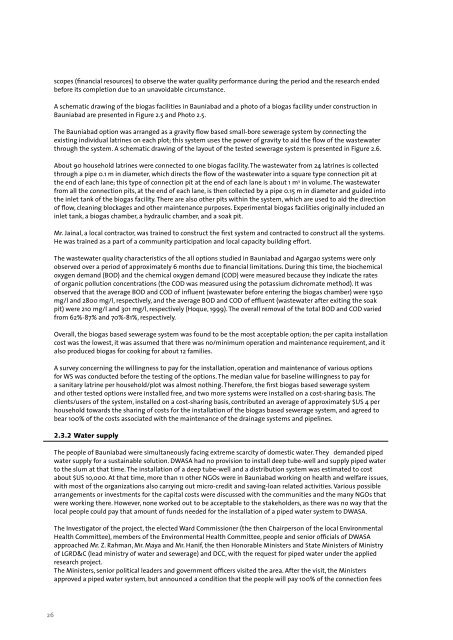Untitled - UNU-IAS - United Nations University
Untitled - UNU-IAS - United Nations University
Untitled - UNU-IAS - United Nations University
Create successful ePaper yourself
Turn your PDF publications into a flip-book with our unique Google optimized e-Paper software.
scopes (financial resources) to observe the water quality performance during the period and the research ended<br />
before its completion due to an unavoidable circumstance.<br />
A schematic drawing of the biogas facilities in Bauniabad and a photo of a biogas facility under construction in<br />
Bauniabad are presented in Figure 2.5 and Photo 2.5.<br />
The Bauniabad option was arranged as a gravity flow based small-bore sewerage system by connecting the<br />
existing individual latrines on each plot; this system uses the power of gravity to aid the flow of the wastewater<br />
through the system. A schematic drawing of the layout of the tested sewerage system is presented in Figure 2.6.<br />
About 90 household latrines were connected to one biogas facility. The wastewater from 24 latrines is collected<br />
through a pipe 0.1 m in diameter, which directs the flow of the wastewater into a square type connection pit at<br />
the end of each lane; this type of connection pit at the end of each lane is about 1 m 3 in volume. The wastewater<br />
from all the connection pits, at the end of each lane, is then collected by a pipe 0.15 m in diameter and guided into<br />
the inlet tank of the biogas facility. There are also other pits within the system, which are used to aid the direction<br />
of flow, cleaning blockages and other maintenance purposes. Experimental biogas facilities originally included an<br />
inlet tank, a biogas chamber, a hydraulic chamber, and a soak pit.<br />
Mr. Jainal, a local contractor, was trained to construct the first system and contracted to construct all the systems.<br />
He was trained as a part of a community participation and local capacity building effort.<br />
The wastewater quality characteristics of the all options studied in Bauniabad and Agargao systems were only<br />
observed over a period of approximately 6 months due to financial limitations. During this time, the biochemical<br />
oxygen demand (BOD) and the chemical oxygen demand (COD) were measured because they indicate the rates<br />
of organic pollution concentrations (the COD was measured using the potassium dichromate method). It was<br />
observed that the average BOD and COD of influent (wastewater before entering the biogas chamber) were 1950<br />
mg/l and 2800 mg/l, respectively, and the average BOD and COD of effluent (wastewater after exiting the soak<br />
pit) were 210 mg/l and 301 mg/l, respectively (Hoque, 1999). The overall removal of the total BOD and COD varied<br />
from 62%-87% and 70%-81%, respectively.<br />
Overall, the biogas based sewerage system was found to be the most acceptable option; the per capita installation<br />
cost was the lowest, it was assumed that there was no/minimum operation and maintenance requirement, and it<br />
also produced biogas for cooking for about 12 families.<br />
A survey concerning the willingness to pay for the installation, operation and maintenance of various options<br />
for WS was conducted before the testing of the options. The median value for baseline willingness to pay for<br />
a sanitary latrine per household/plot was almost nothing. Therefore, the first biogas based sewerage system<br />
and other tested options were installed free, and two more systems were installed on a cost-sharing basis. The<br />
clients/users of the system, installed on a cost-sharing basis, contributed an average of approximately $US 4 per<br />
household towards the sharing of costs for the installation of the biogas based sewerage system, and agreed to<br />
bear 100% of the costs associated with the maintenance of the drainage systems and pipelines.<br />
2.3.2 Water supply<br />
The people of Bauniabad were simultaneously facing extreme scarcity of domestic water. They demanded piped<br />
water supply for a sustainable solution. DWASA had no provision to install deep tube-well and supply piped water<br />
to the slum at that time. The installation of a deep tube-well and a distribution system was estimated to cost<br />
about $US 10,000. At that time, more than 11 other NGOs were in Bauniabad working on health and welfare issues,<br />
with most of the organizations also carrying out micro-credit and saving-loan related activities. Various possible<br />
arrangements or investments for the capital costs were discussed with the communities and the many NGOs that<br />
were working there. However, none worked out to be acceptable to the stakeholders, as there was no way that the<br />
local people could pay that amount of funds needed for the installation of a piped water system to DWASA.<br />
The Investigator of the project, the elected Ward Commissioner (the then Chairperson of the local Environmental<br />
Health Committee), members of the Environmental Health Committee, people and senior officials of DWASA<br />
approached Mr. Z. Rahman, Mr. Maya and Mr. Hanif, the then Honorable Ministers and State Ministers of Ministry<br />
of LGRD&C (lead ministry of water and sewerage) and DCC, with the request for piped water under the applied<br />
research project.<br />
The Ministers, senior political leaders and government officers visited the area. After the visit, the Ministers<br />
approved a piped water system, but announced a condition that the people will pay 100% of the connection fees<br />
26
















